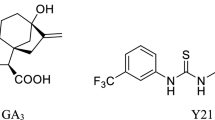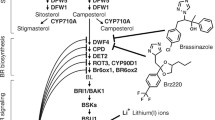Abstract
Plant growth retardants can enhance the lodging resistance of crops and prevent yield losses. In this study, we used the crystal structure of the gibberellin receptor GIBBERELLIN INSENSITIVE DWARF1 (GID1) to aid the discovery of novel growth retardants. The Maybridge database was filtered based on multiple-screening analysis, including pharmacophore modeling, target structures, Lipinski’s rules of 5, and physicochemical properties. Finally, the 1,3-benzodioxole compounds were screened and their potential interaction mechanisms, synthesis, and biological activity on the root lengths of wild-type and mutant-type Arabidopsis thaliana were investigated. The results showed that the compounds inhibited root growth in WT A. thaliana at a range of concentrations, with optimal inhibition observed at 100 μmol/L. The inhibition by compound HTS05309 was comparable to that of uniconazole (100%). Quantitative experiments confirmed that the compounds inhibited A. thaliana growth. These results suggested that novel plant growth retardants have been identified based on computational-aided discovery.





Similar content being viewed by others
References
Abrahamian E, Fox PC, Naerum L, Christensen IT, Thøgersen H, Clark RD (2003) Efficient generation, storage, and manipulation of fully flexible pharmacophore multiplets and their use in 3-D similarity searching. J Chem Inf Comput Sci 43:458–468. https://doi.org/10.1021/ci025595r
Adriansen E, Odgaard P (1997) Residues of paclobutrazol and uniconazole in nutrient solutions from ebb and flood irrigation of pot plants. Sci Horic 69:73–83. https://doi.org/10.1016/S0304-4238(96)00982-X
Chen X, Gan Q, Feng CG, Liu X, Zhang Q (2018) Virtual screening of novel and selective inhibitors of PTP1B over TCPTP using a bidentate inhibition strategy. J Chem Inf Model 58:837–847. https://doi.org/10.1021/acs.jcim.8b00040
Clark RD, Strizhey A, Leonard JM, Blake JF, Matthew JB (2002) Consensus scoring for ligand/protein interactions. J Mol Graph Model 20:281–295. https://doi.org/sci-hub.tw/10.1016/s1093-3263(01)00125-5
Duan HX, Li DL, Liu HC, Liang DS, Yang XL (2013) Computational insight into novel molecular recognition mechanism of different bioactive GAs and the Arabidopsis receptor GID1A. J Mol Model 19:4613–4624. https://doi.org/10.1007/s00894-013-1971-0
Garcia-Martinez JL, Gil J (2002) light regulation of gibberellin biosynthesis and mode of action. J Plant Growth Regul 20:354–368. https://doi.org/10.1007/s003440010033
Hauvermale AL, Ariizumi T, Steber CM (2014) The roles of the GA receptors GID1a, GID1b, and GID1c in Sly1-independent GA signaling. Plant Signal Behav 9:2125–2139. https://doi.org/10.4161/psb.28030
Hirano K, Asano K, Tsuji H, Kawamura M, Mori H (2010) Characterization of the molecular mechanism underlying gibberellin perception complex formation in rice. Plant Cell 22:2680–2696. https://doi.org/10.1105/tpc.110.075549
Hirano K, Nakajima M, Asano K, Nishiyama T, Sakakibara H, Kojima M, Katoh E, Xiang H, Tanahashi T, Hasebe M (2007) The GID1-mediated gibberellin perception mechanism is conserved in the lycophyte selaginella moellendorffii but not in the bryophyte physcomitrella patens. Plant Cell 19:3058–3079. https://doi.org/10.1105/tpc.107.051524
Hornak V, Abel R, Okur A, Strockbine B, Roitberg A, Simmerling C (2006) Comparison of multiple AMBER force fields and development of improved protein backbone parameters. Proteins 65:712–725. https://doi.org/10.1002/prot.21123
Huang N, Shoichet BK, Irwin JJ (2006) Benchmarking sets for molecular docking. J Med Chem 49:6789–6819. https://doi.org/10.1021/jm0608356
Jain AN (2003) Surflex: fully automatic flexible molecular docking using a molecular similarity-based a search engine. J Med Chem 46:499–511. https://doi.org/10.1021/jm020406h
Jiang K, Otani M, Shimotakahara H, Yoon JM, Park SH, Miyaji T, Nakano T, Nakamura H, Nakajima M, Asami T (2017) Substituted phthalimide AC94377 is a selective agonist of the gibberellin receptor GID1. Plant Physiol 133:825–835. https://doi.org/10.1104/pp.16.00937
Kelder J, Grootenhuis PDJ, Bayada DM, Delbressine LPC, Ploemen JP (1999) Polar molecular surface as a dominating determinant for oral absorption and brain penetration of drugs. Pharm Res 16:1514–1519. https://doi.org/10.1023/a:1015040217741
Liang ZB, Xi QL (2018) π-Cation interactions in molecular recognition: perspectives on pharmaceuticals and pesticides. J Agric Food Chem 66:3315–3323. https://doi.org/10.1021/acs.jafc.8b00758
Matsuoka M (2003) Gibberellin signaling: how do plant cells respond to ga signals? J Plant Growth Regul 22:123–125. https://doi.org/10.1007/s00344-003-0039-2
Murase K, Hirano Y, Sun T, Hakoshima T (2008) Gibberellin-induced DELLA recognition by the gibberellin receptor GID1. Nature 456:459–464. https://doi.org/10.1038/nature07519
Nakajima M, Shimada A, Takashi Y, Kim YC, Park SH, Ueguchi-Tanaka M, Suzuki H, Katoh E, Iuchi S, Kobayashi M, Maeda T, Matsuoka M, Yamaguchi I (2006) Identification and characterization of Arabidopsis gibberellin receptors. Plant J 46:880–889. https://doi.org/10.1111/j.1365-313x.2006.02748.x
Ozga JA, Reinecke DM (2003) Hormonal interactions in fruit development. J Plant Growth Regul 22:73–81. https://doi.org/10.1007/s00344-003-0024-9
Peng J, Richards DE, Hartley NM, Murphy GP, Devos KM, Flintham JE, Beales J, Fish LJ, Worland AJ, Pelica F, Sudhakar D, Christou P, Snape JW, Gale MD, Harberd NP (1999) 'Green revolution' genes encode mutant gibberellin response modulators. Nature 400:256–261. https://doi.org/10.1038/22307
Petracek PD, Silverman FP, Greene DW (2013) A history of commercial plant growth regulators in apple production. HortScience 38:937–942. https://doi.org/10.21273/HORTSCI.38.5.937
Platzer S, Kar M, Leymaa R, Chiba S, Jirsa Roller AF, Krachler R, MacFarlane DR, Kandioller W, Keppler BK (2016) Task-specific thioglycolate ionic liquids for heavy metal extraction: synthesis, extraction efficacies and recycling properties. J Hazard Mater 324:241–249. https://doi.org/10.1016/j.jhazmat.2016.10.054
Rademacher W (2015) Plant growth regulators: backgrounds and uses in plant production. J Plant Growth Regul 34:845–872. https://doi.org/10.1007/s00344-015-9541-6
Richmond NJ, Abrams CA, Wolohan PR, Abrahamian E, Willett P, Clark RD (2006) GALAHAD: 1. Pharmacophore identification by hypermolecular alignment of ligands in 3D. J Comput Aid Mol Des 20:567–587. https://doi.org/10.1007/s10822-006-9082-y
Sander T, Freyss J, Von KM, Rufener C (2015) DataWarrior: an open-source program for chemistry aware data visualization and analysis. J Chem Inf Model 55:460–473. https://doi.org/10.1021/ci500588j
Suttle JC, Hultstr JF (1987) Physiological studies of a synthetic gibberellin-like bioregulator. Plant Physiol 84:1068–1073. https://doi.org/10.1104/pp.84.4.1068
Suttle JC, Hultstr JF, Tanaka FS (1992) The biological activities of five azido N-substituted phthalimides: potential photoaffinity reagents for gibberellin receptors. Plant Growth Regul 11:311–318. https://doi.org/10.1007/bf00024570
Tian H, Xu YR, Liu SJ, Jin DS, Zhang JJ, Duan LS, Tan WM (2017) Synthesis of gibberellic acid derivatives and their effects on plant growth. Molecules 22:694–703. https://doi.org/10.3390/molecules22050694
Ueguchi-Tanaka M, Ashikari M, Nakajima M, Itoh H, Katoh E, Kobayashi M, Chow TY, Hsing YI, Hsing H, Yamaguchi I, Matsuoka M (2005) Gibberellin insensitive dwarf1 encodes a soluble receptor for gibberellin. Nature 437:693–698. https://doi.org//10.1038/nature04028
Wang J, Wolf RM, Caldwell JW, Kollman PA, Case DA (2004) Development and testing of a general amber force field. J Comput Chem 25:1157–1174. https://doi.org/10.1002/jcc.20035
Yalpani N, Suttle JC, Hultstr JF, Rodaway SJ (1989) Competition for in vitro [3H] gibberellin A4 binding in cucumber by substituted phthalimides: comparison with in vivo gibberellin-like activity. Plant Physiol 91:823–828. https://doi.org/10.1104/pp.91.3.823
Yan JB, Li SH, Gu M, Yao RF, Li YW, Chen J, Yang M, Nan FJ, Xie DX (2016) Endogenous bioactive jasmonate is composed of a set of (+)-7-iso-JA-amino scid conjugates. Plant Physiol 172:2154–2164. https://doi.org/10.1104/pp.16.00906
Yoon JY, Nakajima M, Mashiguchi K, Park SH, Otania M, Asami T (2013) Chemical screening of an inhibitor for gibberellin receptors based on a yeast two-hybrid system. Bioorg Med Chem Lett 23:1096–1098. https://doi.org/10.1016/j.bmcl.2012.12.007
Zhu YL, Beroza P, Artis DR (2014) Including explicit water molecules as part of the protein structure in MM/PBSA calculations. J Chem Inf Model 54:462–469. https://doi.org/10.1021/ci4001794
Acknowledgements
This work was financially supported by the National Key Research and Development Program of China (2017YFD0201300) and the National Natural Science Foundation of China (31872850).
Author information
Authors and Affiliations
Contributions
Jine Wang carried out drug calculation, biological activity experiments and manuscript writing; Zhikun Yang carried out the synthesis of lead compounds, biological activity experiments and chapter writing; Hongxia Duan helped to carry out experimental analysis and control the writing progress and review of manuscripts; Liusheng Duan confirmed the research content, controlled the progress of the test and the quality of the manuscript writing; Weiming Tan conceived and designed experiments, and controlled the writing progress and review of manuscripts.
Corresponding authors
Ethics declarations
Conflict of interest
The authors declare no conflict of interest.
Additional information
Publisher's Note
Springer Nature remains neutral with regard to jurisdictional claims in published maps and institutional affiliations.
Electronic supplementary material
Below is the link to the electronic supplementary material.
Rights and permissions
About this article
Cite this article
Wang, J., Yang, Z., Duan, H. et al. Computational-Aided Discovery of Novel 1,3-Benzodioxole Plant Growth Retardants. J Plant Growth Regul 39, 888–896 (2020). https://doi.org/10.1007/s00344-019-10030-1
Received:
Accepted:
Published:
Issue Date:
DOI: https://doi.org/10.1007/s00344-019-10030-1




